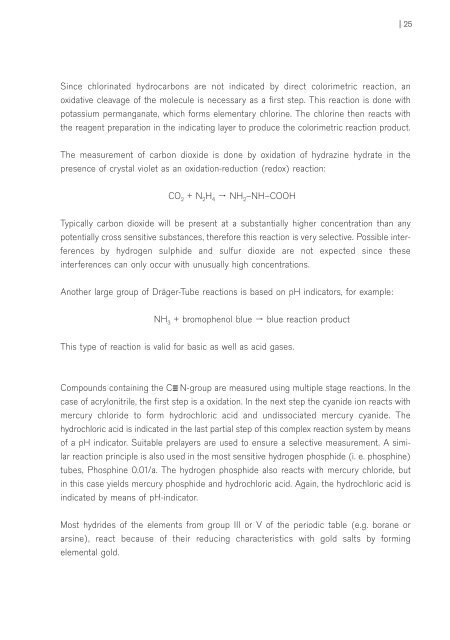Create successful ePaper yourself
Turn your PDF publications into a flip-book with our unique Google optimized e-Paper software.
|25<br />
A<br />
2.2. Chemical Basis – Reaction Mechanisms<br />
Since chlorinated hydrocarbons are not indicated by direct colorimetric reaction, an<br />
oxidative cleavage of the molecule is necessary as a first step. This reaction is done with<br />
potassium permanganate, which forms elementary chlorine. The chlorine then reacts with<br />
the reagent preparation in the indicating layer to produce the colorimetric reaction product.<br />
The measurement of carbon dioxide is done by oxidation of hydrazine hydrate in the<br />
presence of crystal violet as an oxidation-reduction (redox) reaction:<br />
CO 2 + N 2 H 4 ä NH 2 –NH–COOH<br />
Typically carbon dioxide will be present at a substantially higher concentration than any<br />
potentially cross sensitive substances, therefore this reaction is very selective. Possible interferences<br />
by hydrogen sulphide and sulfur dioxide are not expected since these<br />
interferences can only occur with unusually high concentrations.<br />
Another large group of Dräger-Tube reactions is based on pH indicators, for example:<br />
NH 3 + bromophenol blue ä blue reaction product<br />
This type of reaction is valid for basic as well as acid gases.<br />
Compounds containing the C N-group are measured using multiple stage reactions. In the<br />
case of acrylonitrile, the first step is a oxidation. In the next step the cyanide ion reacts with<br />
mercury chloride to form hydrochloric acid and undissociated mercury cyanide. The<br />
hydrochloric acid is indicated in the last partial step of this complex reaction system by means<br />
of a pH indicator. Suitable prelayers are used to ensure a selective measurement. A similar<br />
reaction principle is also used in the most sensitive hydrogen phosphide (i. e. phosphine)<br />
tubes, Phosphine 0.01/a. The hydrogen phosphide also reacts with mercury chloride, but<br />
in this case yields mercury phosphide and hydrochloric acid. Again, the hydrochloric acid is<br />
indicated by means of pH-indicator.<br />
Most hydrides of the elements from group III or V of the periodic table (e.g. borane or<br />
arsine), react because of their reducing characteristics with gold salts by forming<br />
elemental gold.


















